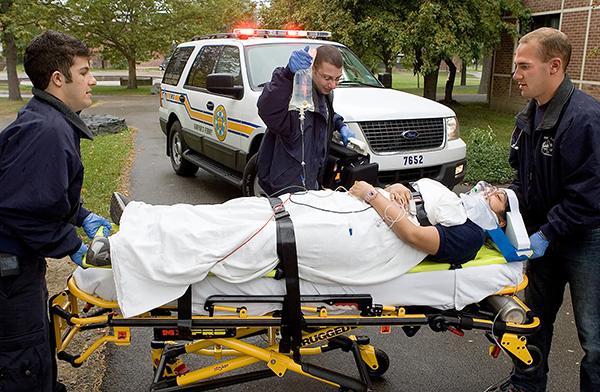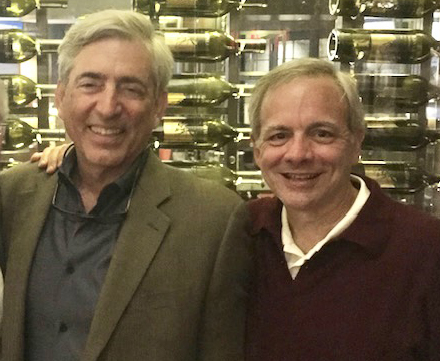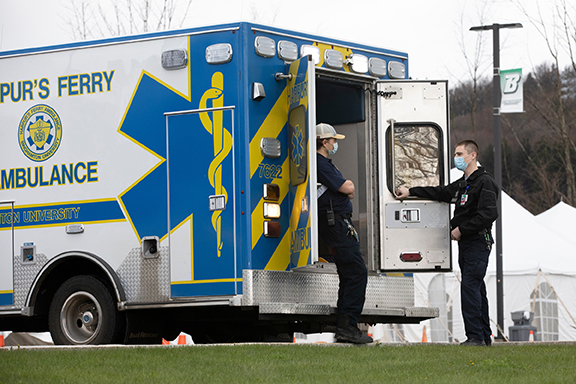50 years later, Harpur’s Ferry still saves lives
Alumni of student-run ambulance service look back on its impact

Sal Caruana ’73 couldn’t help but compliment the current and alumni members of Harpur’s Ferry standing in front of him.
“I’ve been in New York my entire life and I’ve done a lot of things and been a lot of places, and I’ve never been in a room with more heroes before,” Caruana said at a New York City celebration in January. “That’s who you people are to me. You are Binghamton University heroes.”
Caruana’s praise holds a lot of weight in 2023: The student-run, volunteer ambulance service he helped found with Adam Bernstein ’73 and Jon-Marc Weston ’73 marks its 50th anniversary this year. And with that half-century milestone comes much reflection about how one of the country’s oldest collegiate emergency medical services has not only helped many Binghamton students springboard into healthcare careers, but it’s also saved lives on and off campus.
Driving in a hearse
In May 1970, The Grateful Dead played a now legendary show in the West Gym. But things took a turn at the end of the night when eight concertgoers were unconscious and needed medical attention.
“There was no plan or mechanism to get them the medical care that they needed other than calling local hospitals and asking for ambulances, which in the middle of the night were [in] very short supply,” Caruana recalls.
Drug-related issues were common at the time, and as a result, Bernstein had founded High Hopes (now known as non-emergency helpline SEEK), a counseling service for students. However, Caruana recalls that Bernstein “was becoming more and more exasperated” with how many people came into the clinic needing emergency services. The two and Weston brainstormed solutions with others and ultimately decided they’d need to take matters into their own hands.
Fundraising for what would become Harpur’s Ferry began in 1972 with the support of other students and the Tau Alpha Upsilon fraternity. The following year, Weston ended up buying a Cadillac hearse from a funeral home in Johnson City, N.Y., for $125. It wasn’t long before the hearse stopped working, so he did a little more research this time and learned that fire departments in New York had to replace their ambulances every 10 years. He purchased another hearse-style vehicle for $1,200. Members drove around campus and kept sirens and lights on to garner attention.
Once Harpur’s Ferry was up and running, Weston, Caruana and Bernstein were about to graduate. A new generation of students was ready to take on responsibilities, armed with education from some of the classes they took at Binghamton, Red Cross courses, first-aid training and CPR training.
“It wasn’t something we really expected to be successful,” Weston says. “It was worth a try.”
Life-changing experiences
By the 1990s, Harpur’s Ferry was in full swing as a campus resource and as a place where students interested in the medical field could gain real-world experience.
Dr. Jim Rodriguez ’99 was one of those people, and his first call hit close to home. When he joined Harpur’s Ferry during his sophomore year, his brother was a first-year student at Binghamton. While Rodriguez was on his shift, he received a call to his brother’s room in Chenango Hall.
“Mom’s going to kill you” were the first words out of Rodriguez’s mouth when he saw his brother’s bruises and black eyes. He had gotten into a scuffle that night, but thing turned out OK afterward. Rodriguez’s experience of having to care for his brother not only prepared him for the unexpected, but it also helped him to develop a personable bedside manner in his career as an emergency medicine physician.
“I learned how to take care of people like they were my brother, because they could be,” says Rodriguez, who now works in New York City.
By the 2000s, Harpur’s Ferry had long outgrown the 1970s hearse. And it wasn’t just a service for Binghamton University students anymore — it helped the broader community.
In June 2006, a flood in the mid- Atlantic impacted Binghamton, and the University opened a special medical-needs shelter inside the Events Center for those in the community. Harpur’s Ferry members such as Ben Krakauer ’05, MPA ’07, experienced firsthand what it was like to have a positive impact on more than just his peers.
“When you step back and think about it, you had a bunch of 18- to 22-year-olds running this very large operation that kept people healthy and safe and fed and taken care of during a really tragic event,” he says.
Krakauer, who also served as Harpur’s Ferry chief, says he could “draw a straight line” from his time at Binghamton to his current role as senior advisor to the Office of the Administrator at FEMA thanks to relationships he cultivated as an undergraduate. To this day, he still applies the clinical skills he learned in Harpur’s Ferry at FEMA. Krakauer traveled to Florida last September when Hurricane Ian hit, and he recalls being able to “have very direct conversations with hospital executives in Lee County to understand what their challenges were and make sure they were getting the help they needed.”
Harpur’s Ferry was also where Krakauer met his wife, Rebecca Krakauer ’07. Rebecca was inspired to join after she was in a car accident in high school and had a positive experience with the EMTs who took care of her. She found her own EMT experience to “be really empowering,” especially since she was able to help a professor get proper medical care after he had a seizure in class.
Having the opportunity to work and collaborate with others was what propelled her to pursue public health with a specific focus on behavioral health issues.
“Going on different calls, seeing people in different health situations, actually directly impacted my current career,” she says. “It gave me a view of life that I hadn’t previously seen before.”
Having perspective is everything in this particular line of work. For Kelly Martin ’13, that meant learning about teamwork and having empathy for each person on that team. When she was a member of Harpur’s Ferry in September 2011, another flood hit the Binghamton area, and the University opened the West Gym and Events Center as evacuation shelters. The experience helped solidify those lessons.
As a physician assistant today, Martin sometimes has high school and college students shadow her. She encourages them to because “if you can find the time to prioritize it in the business and [the] multiple directions you’re being pulled in a college life, it really shows that maybe you are cut out for this field. It is a very unique field.”
A lasting impact
When Brandon Carbone, the service’s current chief/executive director and an MBA graduate student, first joined Harpur’s Ferry as an undergraduate, he asked himself how he could ever fill the shoes of those who came before him. But after working his way up, meeting alumni when they’ve returned to do special medical trainings and celebrating the 50th anniversary, Carbone sees just how time and experience can change everything.
“It’s kind of crazy to think that through 50 years we’ve gone from something so small to something so large,” he says. “But at the end of the day, everyone plays their part, so it wouldn’t be done without everybody.”
For alumni such as Krakauer, looking back at the Harpur’s Ferry experience and overall impact feels like “a really magical time.”
“At Binghamton University, your fellow students are showing up to take care of you,” he says. “And there’s an immediate comfort there. There’s immediate understanding. There’s an immediate trust that I think forms between the ambulance crew and the patient because you’re all really part of one community.”
And for a founder like Caruana, starting a legacy like that has been humbling.
“We can’t quantify in the last 50 years how many lives have been saved because of Harpur’s Ferry,” he says. “Or how many individuals, on campus and off campus, got emergency care they needed or got the transportation they needed to get to the hospital, which saved their lives. But to know you are a part, along with many, many other people, of that statistic — of that successful statistic, of that successful outcome— is incredibly rewarding.”



